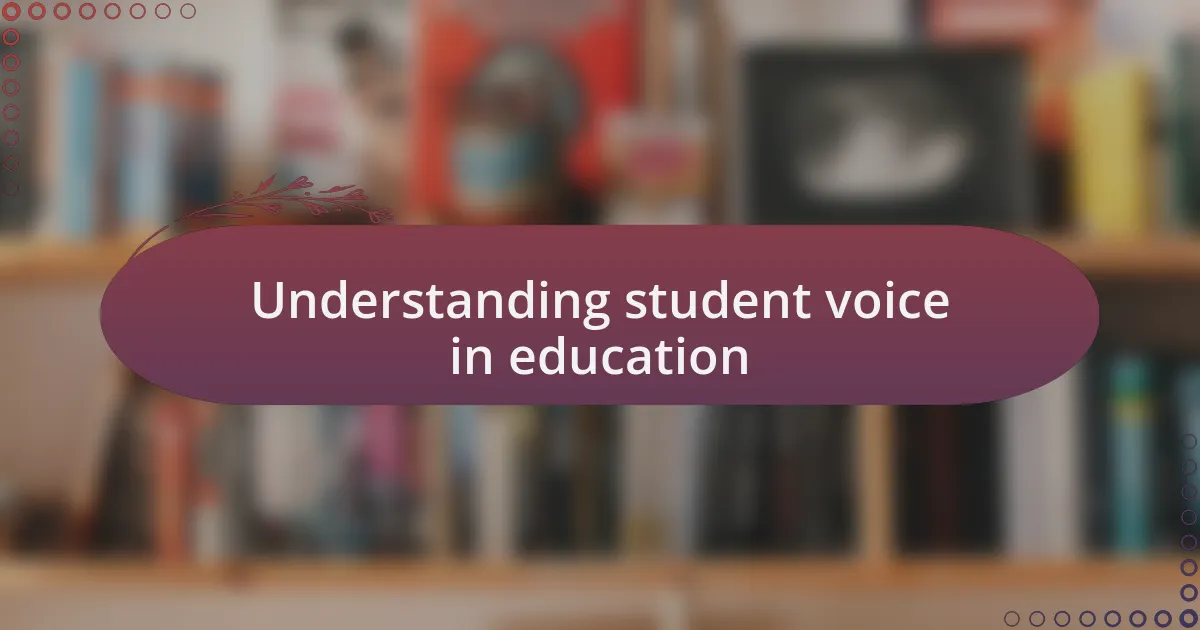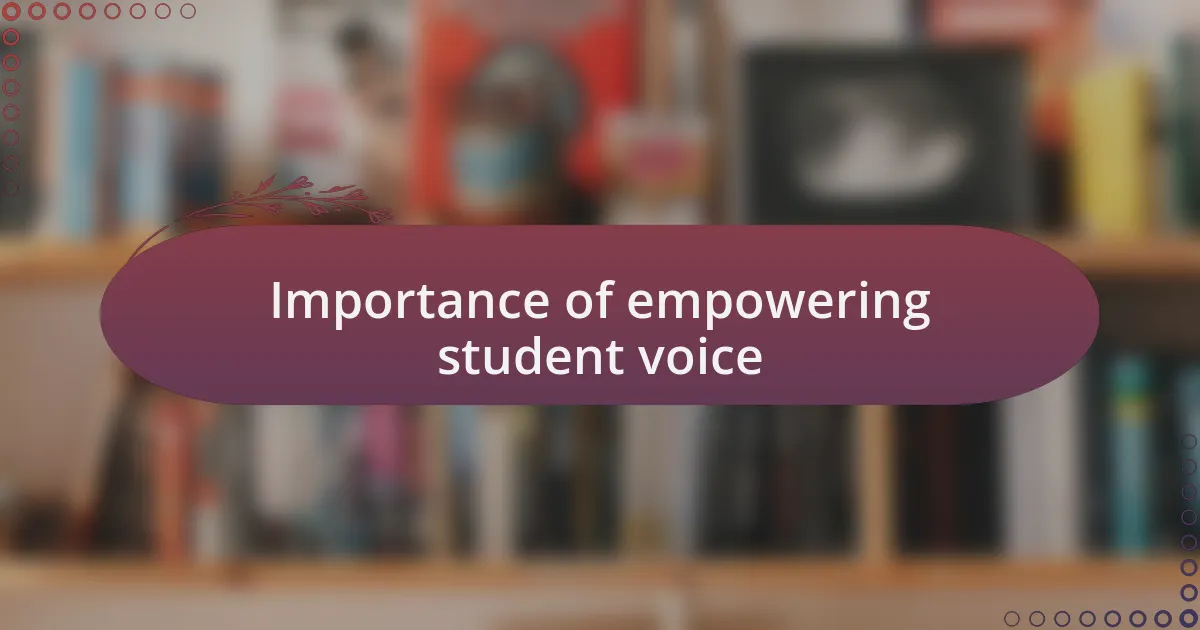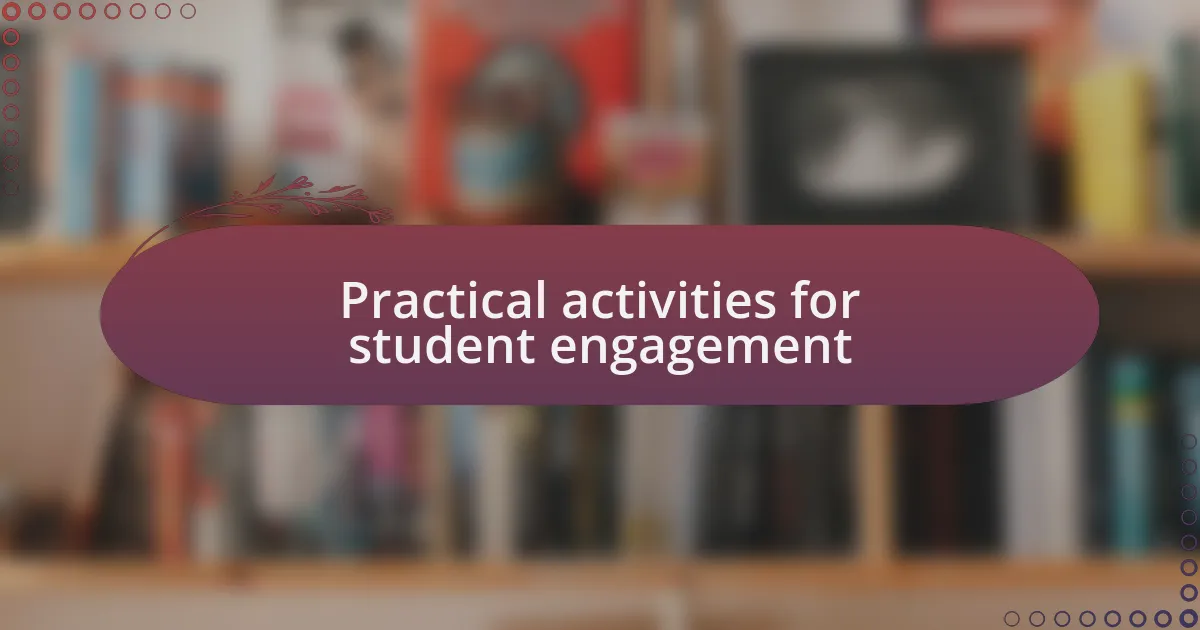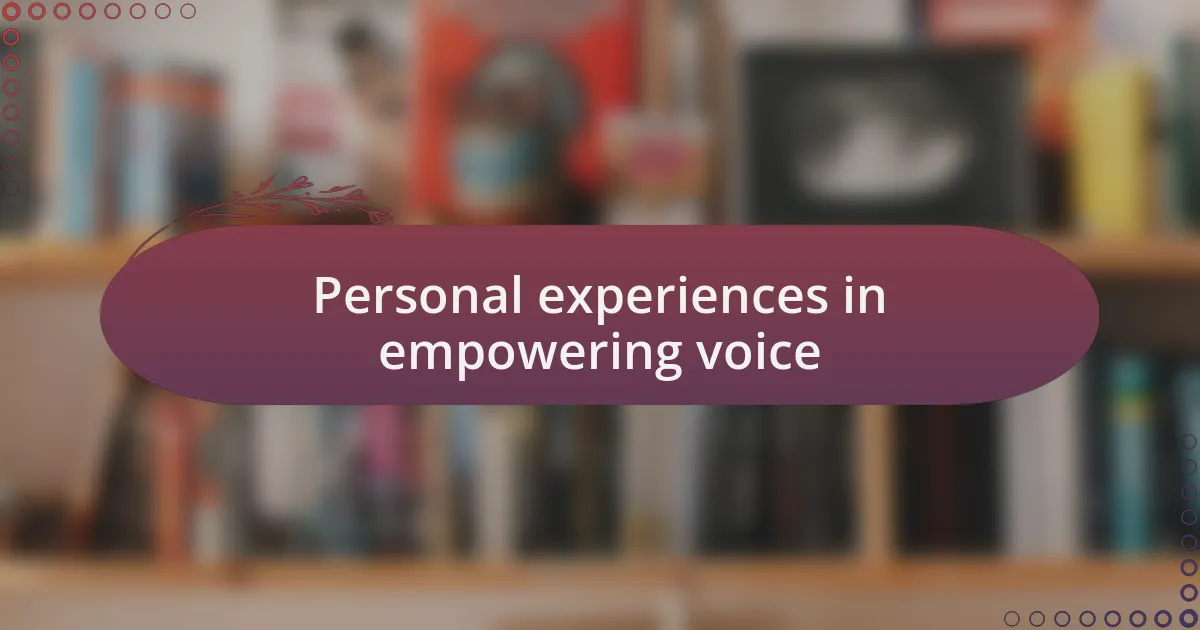Key takeaways:
- Empowering student voice enhances engagement and builds confidence, making students feel valued and invested in their education.
- Fostering open communication, regular class meetings, and project-based learning are effective strategies to amplify student voices.
- Utilizing digital platforms and interactive tools encourages participation, allowing students to express their opinions freely and comfortably.
- Real-world collaborative projects and creative assignments significantly boost student engagement, helping them connect meaningfully with their learning.

Understanding student voice in education
Understanding student voice in education is crucial, as it gives learners the opportunity to express their thoughts, ideas, and needs. I often reflect on how empowering it felt when my teachers encouraged me to share my perspective in class discussions. It made me realize that my opinions mattered, which ignited a passion for learning and engagement.
Many educators may wonder how to create an environment where student voices are genuinely heard. In my experience, fostering open communication is key. Think back to a moment when you were in school; didn’t you appreciate when a teacher actively sought your input? That simple act can transform students from passive participants into empowered contributors, showcasing their unique insights and experiences.
When we talk about student voice, we’re not just discussing the right to speak; we’re exploring the emotional connection that comes with being valued. I remember a time when a student-led initiative led to changes in our curriculum. Seeing my peers step up and lead discussions about what we wanted to learn made me realize how necessary it is for educators to listen. How many times have we overlooked the rich perspectives young minds can offer? It’s a reminder that student voice isn’t just important—it’s essential for a thriving educational environment.

Importance of empowering student voice
Empowering student voice is vital because it not only enhances engagement but also builds confidence in young learners. I vividly remember a project where students were invited to select the topics we wanted to explore. The excitement in the room was palpable, and it made me realize how much more invested we were in our learning when we had a say. Can you imagine the difference it would make if all classrooms embraced this dynamic?
When students feel their opinions matter, it fosters a sense of ownership over their education. I once participated in a feedback session where our suggestions reshaped a school event. Seeing our ideas put into action made me feel valued as part of a community. Isn’t that what education should be about—creating a collaborative environment where every voice lends to the collective growth?
Moreover, amplifying student voices catalyzes necessary changes in educational practices. Reflecting on my own experiences, I’ve seen how a simple suggestion could lead to improved classroom dynamics. When students feel heard, they’re more likely to take initiative and develop critical thinking skills. Isn’t it time we recognize the profound impact that empowering youth can have on shaping the future of education?

Strategies for fostering student voice
One effective strategy for fostering student voice is to implement regular class meetings where students can share their thoughts and ideas. I remember attending a weekly gathering in my classroom where we discussed everything from lesson plans to classroom rules. It was amazing how just a few dedicated moments each week transformed our rapport; students felt empowered to speak up and contribute, creating a lively dialogue that made everyone feel valued. Have you considered how such simple traditions could elevate engagement and collaboration in your classroom?
Another powerful approach is incorporating project-based learning where students can choose their own projects based on their interests. This strategy not only nurtures creativity but also allows students to explore topics they are passionate about. I still recall a project I took on about environmental sustainability, which sparked lively debates and innovative ideas among my peers. How exciting would it be to encourage students to dive deep into subjects they care about, knowing they could lead discussions and findings that resonate with their classmates?
Lastly, providing platforms for student feedback—like suggestion boxes or surveys—can significantly contribute to amplifying their voices. I once participated in an anonymous survey about curriculum changes, and it was refreshing to see how our feedback was taken seriously. When we realize that our opinions can directly influence the learning environment, it instills a sense of responsibility and commitment. Wouldn’t it be remarkable to create an educational setting where students feel their insights can shape their own experience?

Tools to enhance student participation
One effective tool for enhancing student participation is digital platforms like Google Classroom or Padlet, which enable students to share ideas and resources in asynchronous discussions. I remember once using Padlet for a literature class project, where we collectively brainstormed themes and character motivations. It was incredible to see how students who might typically remain quiet in a verbal discussion became lively contributors in this online environment. Have you ever noticed how technology can sometimes break down those barriers and encourage more voices to join the conversation?
Another valuable tool is interactive polling software, such as Poll Everywhere or Mentimeter, which allows students to express their opinions in real time. I once used Poll Everywhere during a physics lesson to gauge class understanding of concepts, and the immediate feedback was enlightening. It empowered my students to voice their confusion without the fear of being judged, which led to rich follow-up discussions. How might your teaching change if every student felt comfortable sharing their thoughts instantly?
Lastly, utilizing brainstorming apps, like MindMeister, can foster collaboration and creativity among students. I vividly recall a group project where we mapped out our ideas visually, and it transformed our collective thinking. The thrill of watching our thoughts connect and expand in real time was electrifying. Have you considered how visual tools could change the dynamic of your classroom discussions, making participation feel more inclusive and energetic?

Practical activities for student engagement
Incorporating collaborative projects can significantly enhance student engagement, especially when they involve real-world issues. I remember facilitating a project where students developed action plans for environmental sustainability in our community. They were not just participants; they were researchers, advocates, and problem solvers, passionately discussing their ideas and how they could impact change. Can you recall a time when your students took ownership of a project and truly felt like they made a difference?
Another effective activity is role-playing or simulations, where students step into different perspectives and scenarios. Once, during a history lesson, I had students act out historical figures during a debate on key events. The energy in the room surged as they passionately defended their characters, and I could see how deeply they connected with the material. How often do you see students come alive when they can actively engage rather than passively receive information?
Finally, leveraging artistic expression in assignments can yield amazing results. I once encouraged students to create short films based on literary themes we studied. The creativity that flowed was astounding, and watching my students present their work with pride reminded me of their unique talents and insights. Isn’t it fascinating how allowing them to express their understanding in innovative ways can elevate their learning experience?

Personal experiences in empowering voice
One memorable experience I had was when I organized a student-led conference, allowing learners to choose topics that mattered to them. I was amazed by the enthusiasm they displayed as they prepared their presentations, and it struck me how empowering it was for them to voice their interests and passions. Have you ever witnessed students rallying around a cause they cared about so deeply that it ignited a fire in their hearts?
During a literature class, I decided to host an open forum where students could share their interpretations of the texts we were reading. The dialogue that unfolded was exhilarating; they challenged each other’s ideas and built on one another’s thoughts. I felt a sense of pride watching them articulate their perspectives and realize that their voices were valued in our classroom community. Isn’t it a joy to create a space where students feel comfortable sharing their unique views?
Another instance that stands out involved a project where students collaborated with local leaders to propose solutions to community challenges. As they engaged with these leaders, I saw their confidence soar—what started as uncertainty transformed into conviction as they recognized their ability to effect change. Reflecting on that experience, I wonder: how often do we provide students the opportunity to engage directly with the world outside the classroom?